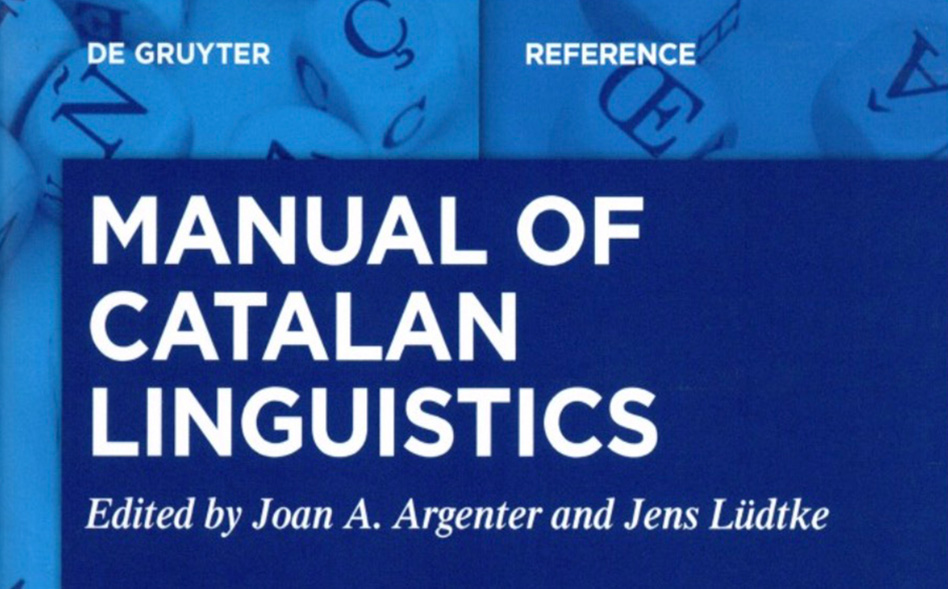Last April 6th, in the middle of the pandemic lockdown, the Manual of Catalan Linguistics (Berlin: De Gruyter) was issued, edited by Joan A. Argenter, Emeritus Professor at the department, and the late Prof. Dr. Jens Lüdtke, Universität Heidelberg.
This manual claims to be representative of Catalan Linguistics as cultivated mainly by the Catalans, Valencians and Balearics themselves, and some European and Noth-Americans, totaling 34 authors. Scholars from twelve universities and institutions across the Catalan-speaking area contribute to the work, among which several members of the department: professors Mar Massanell, Gemma Rigau, Jaume Mateu, Xavier Villalba as well as professor Montserrat Bacardí, member of the Faculty of Translation and Interpreting, UAB.
The editors of this Manual of Catalan Linguistics agreed to organise it thematically rather than by discipline or approach. This gave them the opportunity to gather together authors of different disciplines and stance to favour a variety of views on related topics. Let us take sociolinguistics for the sake of argument: there is no single chapter on sociolinguistics. This may appear to some an incomprehensible omission given the Catalan sociolinguistic setting and the exemplary autochthonous production in the field, but the subject is so interdisciplinary in nature that it is distributed across several chapters. Indeed, the themes dealt with in the book have been assigned to a representative group of highly recognised scholars and professionals, including linguists, philologists, sociolinguists, anthropologists, jurists, language advisors of media, language planners, and others, whose expertise in their topic or field is beyond question.
Regrettably, Jens Lüdtke passed away on 4th January 2019. After two years of working side by side, Joan A. Argenter was left to complete their shared mission alone. He was determined to complete the work they had started together. Thirty-five years after Jens’ Katalanisch. Eine einführende Beschreibung, this Manual of Catalan Linguistics pays tribute to his fruitful career.
Joan A. Argenter, Jens Lüdtke (Edd.), Manual of Catalan Linguistics. Berlin : De Gruyter, 2020. 784 p. (Manuals of Romance Linguistics, 25)
This manual is intended to fill a gap in the area of Romance studies. There is no introduction available so far that broadly covers the field of Catalan linguistics, neither in Catalan nor in any other language. The work deals with the language spoken in Catalonia and Andorra, the Balearic Islands, the region of Valencia, Northern Catalonia and the town of l’Alguer in Sardinia. Besides introducing the ideologies of language and nation and the history of Catalan linguistics, the manual is divided into separate parts embracing the description – grammar, lexicon, variation and varieties – and the history of the language since the early medieval period to the present day. It also covers its current social and political situation in the new local and global contexts. The main emphasis is placed on modern Catalan.
The manual is designed as a companion for students of Catalan, while also introducing specialists of other languages into this field, in particular scholars of Romance languages.
Table of Contents
0. Introduction
Joan A. Argenter
Pages: 1–16
1. Languages, Cultures, Nations: A History of Europe
Joan F. Mira
Pages: 17–36
2. History of Catalan Linguistics
Joan Julià-Muné
Pages: 37–78
LANGUAGE DESCRIPTION
3. Spelling
Xavier Lamuela
Pages: 81–100
4. Phonology, Phonetics, Intonation
Nicolau Dols
Pages: 101–128
5. MORPHOSYNTAX
5.1 Word Classes, Inflectional Categories and Paradigms
Mar Massanell i Messalles
Pages: 129-164
5.2 The Simple Sentence
Gemma Rigau and Manuel Pérez Saldanya
Pages: 165-210
5.3 The Complex Sentence
Manuel Pérez Saldanya and Gemma Rigau
Pages: 211-246
5.4 Modality and Information Structure: Focus, Dislocation, Interrogative and Exclamatory Sentences
Ingo Feldhausen and Xavier Villalba
Pages: 247-270
5.5 Lexicalized Syntax: Phraseology
Jaume Mateu
Pages: 271-286
6. Pragmatics and Text Linguistics
Maria Josep Cuenca
Pages: 287-310
7. LEXICON
7.1 General Lexicon
Josep Martines
Pages: 311–350
7.2 Word-Formation
Jens Lüdtke
Pages: 351-370
8. VARIATION AND VARIETIES
8.1 Dialects
Mar Massanell i Messalles
Pages: 371-396
8.2 Social and Functional Variation in Catalan
Miquel Àngel Pradilla Cardona
Pages: 397–420
9. Language Corpora
Joan Soler Bou
Pages: 421-434
LANGUAGE HISTORY
10. Early Medieval Catalan
Philip D. Rasico
Pages: 437-470
11. The Growth and Expansion of Catalan (1213–1516)
Antoni Ferrando
Pages: 471-484
12. The Origins of Modern Catalan: Cultural and Linguistic Evolution
Miquel Nicolás
Pages: 485-496
13. Renaixença
Jenny Brumme
Pages: 497-516
14. TOWARDS LANGUAGE INSTITUTIONALIZATION
14.1 The Language Reform, the Institut d’Estudis Catalans and the Work of Pompeu Fabra
August Rafanell
Pages: 517–544
14.2 From Pompeu Fabra to the Present Day: Language Change, Hindrance to Corpus and Status Planning
August Rafanell
Pages: 545–560
15 .Onomastics: Personal Names and Place Names
Albert Turull
Pages: 561-580
16. Translation
Montserrat Bacardí and Joaquim Mallafrè
Pages: 581–594
CATALAN TODAY
17. Languages in Contact: A Sociocultural Approach
Joan A. Argenter
Pages: 597–628
18. Language Demography
F. Xavier Vila
Pages: 629–648
19. Language Law and Language Policies
Eva Pons
Pages: 649–668
20. Teaching and Learning of Catalan
F. Xavier Vila
Pages: 669–682
21. Catalan in the Mass Media: The Rise of Stylebooks
Oriol Camps Giralt and Aina Labèrnia Romagosa
Pages: 683–692
22. Terminology and Neology
M. Teresa Cabré and M. Amor Montané
Pages: 693–708
23. Language Ideologies in Society
Emili Boix-Fuster and Kathryn A. Woolard
Pages: 709–722
24. Migration in Catalonia: Language and Diversity in the Global Era
Joan Pujolar
Pages: 723–738
25. Catalan Worldwide
August Bover i Font
Pages: 739–750
List of Contributors
Pages: 751–754
Index
Pages: 755–784


